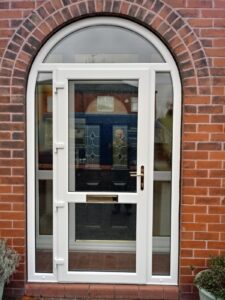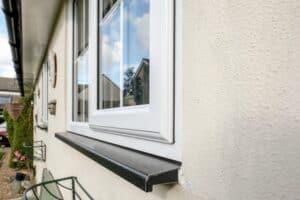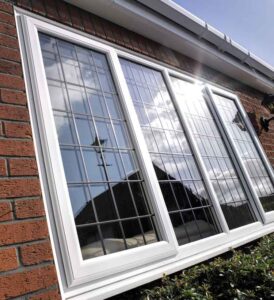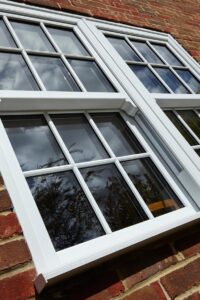A Guide to Popular Window Types for Your Home
Windows are more than just panes of glass shielding us from the elements; they’re the eyes of a home, offering...
Read MoreLast Updated: 29 April 2025
Despite the large strides made with uPVC in recent years, its shoddy reputation forged during the 1980s has been a hard one to shake. Though primarily known for our work with hardwood windows and doors, modern developments made to the material mean we feel confident in offering uPVC windows and doors as a successful timber alternative for homeowners.
To better halt the untrue and sometimes ill-informed misconceptions about uPVC, we thought it’d be helpful to address them head-on.

This is simply not true. In fact, uPVC windows and doors can look however homeowners want them to. All units can be customised through adjustable colouring, glazing, and opening style so that you can enjoy luxury with low maintenance. This versatility is one of the many reasons why homeowners now choose to use uPVC when replacing their windows.
If you’ve heard that uPVC isn’t very strong, we’re sorry to reveal that you’ve been misinformed. It’s actually engineered to be as sturdy and rigid as possible, to allow for effective installation of triple glazing into the units. Simply put, uPVC’s natural strength will never compromise the structural integrity of your home.
uPVC is actually a very eco-friendly material. It’s completely recyclable which means that it can be broken down and used for other purposes when its natural lifespan comes to an end. And there’s no need to take down any trees. Once fitted, uPVC windows and doors are well-equipped to insulate the home too, meaning that less energy is needed to heat up the living space.

Though made from plastic, uPVC windows and uPVC doors are not susceptible to warping and cracking when subjected to heat. The frames come reinforced using galvanised iron, which means that they’ll always retain their shape and size.
Wrong! uPVC windows and doors have an average lifespan of around 20 years, which, while not as long as timber or aluminium, can be extended to double that if quality materials are used. During this time they’ll continue performing and functioning as expected, holding fast against the sun harshness, rapid winds, and cold weather.

uPVC windows and doors can be installed in a wide range of colours and finishes, helping to ensure that they can be customised to suit property styles both classical and contemporary. From classic styles like Chartwell Green and Cream to more authentic woodgrain foils like Rosewood and Irish Oak.
Condensation is a problem that can occur in any frame material. Put simply, the tighter your home is sealed, the more likely it is that you’ll experience some kind of condensation build-up. Therefore, it’s best to incorporate ventilation features to allow air to flow through. Thankfully, most uPVC windows and doors do so naturally.
Older uPVC windows and doors could turn yellow over long periods of time. Since then, modern manufacturing developments have improved, eradicating the possibility for uPVC frames and panels to discolour over time. Yellowing is an issue that’s simply not possible with most modern uPVC systems.
This is one of the most baffling misconceptions we come across. uPVC is in no way high in maintenance. Their ability to be easily cleaned is actually one of uPVC’s biggest advantages, on the rare occasion that homeowners are needed to do. A vast improvement compared to the uPVC and timber of old (especially the latter whereby regular varnishing is required), modern uPVC windows and doors perfectly suit those wanting a ‘fit and forget’ experience.

While it’s true that uPVC might cost a little more than it did in say, the 1980s, a lot of this is merely down to the natural inflation that has occurred in the British economy over time.
Despite this, the quality of uPVC windows and doors has improved greatly, they’re still the most affordable option and can even save you money thanks to multi-chambered profiles which serve to trap any present precious heat.
A common misconception we often encounter is that uPVC windows and doors are non-customisable and only available in standard sizes and designs. This is far from the truth. Thanks to the versatility of uPVC, it is possible to have your windows and doors designed and manufactured to meet your unique requirements. Be it a distinct size for a period property, a unique shape for a design-led new build, or a specific style to match your home’s aesthetics, uPVC can be tailored perfectly.
Some people believe that uPVC isn’t appropriate for period properties due to its modern appearance. In reality, uPVC can be styled to mimic traditional materials like wood, allowing it to blend seamlessly with the aesthetic of period properties while providing the benefits of modern insulation and security.
We hope we’ve managed to clear up just some of the most prominent misconceptions about uPVC, reinforcing our belief that windows and doors engineered in the material are a solid choice when wanting to improve your home.
For more information on our selection of uPVC windows and doors, why not get in touch? You can contact Reddish Joinery either via phone on 0161 696 7474 or send us an online message today.
Windows are more than just panes of glass shielding us from the elements; they’re the eyes of a home, offering...
Read MoreAs a homeowner looking to renovate or someone in the process of building a house, choosing the right windows is...
Read MoreWhen we speak to our customers, they often inform us of the many home improvement projects they’re looking to complete...
Read MoreIf you’ve noticed your window has become difficult to open or close there could be a number of problems going...
Read More